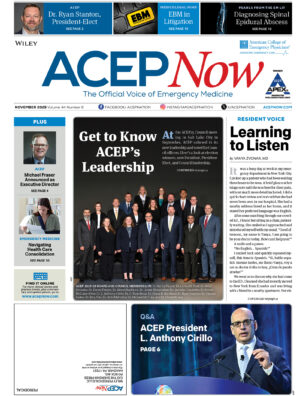
As emergency physicians, we are the first and often the only physicians to see victims of firearm injury. We are the docs who are the first to manage the aftermath of a mass shooting. We are the ones most at risk of active shooters in our own hospitals, and we are the ones who have to handle the legal questions that come with a patient with violent tendencies who has been dropped off at our door by the police. We see both the immediate and long-term effects of these injuries, and of course, many
Explore This Issue
ACEP Now: Vol 38 – No 05 – May 2019of us came to emergency medicine from prehospital or military backgrounds, where we had more immediate firsthand experience. Firearm injury is an issue that impacts all of us.
We see how it’s getting worse. More and more of us are joining the awful club of having had to treat a mass shooting. More and more of us have had family members or friends who have been injured. More and more emergency physicians are being hurt or killed, most tragically and notably with the shooting death of Tamara O’Neal, MD, outside her emergency department at Mercy Hospital in Chicago.
However, we also know that we don’t have to accept injury or disease outbreaks as a fait accompli. We have a long history of mobilizing, as emergency physicians, to identify and then reduce patterns of injury. Doing this work is nonpartisan; it’s based on science and great research. Through this public health approach, emergency medicine has been a critical leader in national and local efforts to reduce car crash deaths and child abuse, plus is leading the charge against opioid overdose deaths, human trafficking, and more.
Emergency medicine is also a leader in developing a public health approach to reduce firearm injuries. Through this approach, we can make a difference in the prevalence, severity, and long-term consequences of gunshot wounds across the country.
A short list of actions by ACEP includes:
- Six years of work by the ACEP Trauma & Injury Prevention Section to highlight the importance of addressing firearm injury as a public health problem
- Lectures on firearm injury prevention at ACEP17 and ACEP18
- A firearm injury prevention policy that was rewritten in 2013 and is currently being reevaluated by the Public Health & Injury Prevention Committee in addition to the original task force
- Completion of a Technical Advisory Group on emergency medicine–relevant firearm injury research, culminating in a publication in Annals of Emergency Medicine in 20161
- Active advocacy for federal funding and universal background checks, in accordance with ACEP’s firearm injury prevention policy
- Completion of two surveys of emergency physicians’ firearm injury prevention practices and beliefs through the EM-PRN network
- Donating $20,000 to the American Foundation for Firearm Injury Reduction in Medicine (AFFIRM), a not-for-profit organization founded and led by emergency physicians
Additionally, emergency physicians have led national non-ACEP-affiliated efforts to change the trajectory of this epidemic. A short and incomplete list includes:
- Development of the “What You Can Do” video series on screening and counseling by Garen J. Wintemute, MD, MPH, at UC-Davis Health in Sacramento, California
- Development of the National Institutes of Health–funded Firearm Safety Among Children and Teens consortium, led by Rebecca Cunningham, MD, FACEP, and Patrick Carter, MD, at the University of Michigan in Ann Arbor, with the collaboration of numerous emergency physicians across the country
- Leadership of the National Network of Hospital-Based Violence Intervention Programs by Kyle Fischer, MD, MPH, of the University of Maryland in College Park; Robert Gore, MD, of Kings County Hospital in Brooklyn, New York; and many more
- Development of novel coalitions between gun shop owners and firearm injury prevention researchers led by Marian (Emmy) Betz, MD, MPH, at the University of Colorado-Denver
- Promotion of the #StopTheBleed training by Eric Goralnick, MD, FACEP, at Brigham and Women’s Hospital in Boston
- Development of a scholarship fund in honor of Dr. O’Neal by the University of Illinois-Chicago residency and a memorial research fund in her name by the AFFIRM and FemInEM
- The #ThisIsOurLane movement, covered in The New England Journal of Medicine with a piece by myself, Dr. Betz, and Cedric Dark, MD, MPH, of Baylor College of Medicine in Houston2
Individual emergency physicians have written numerous publications and led local movements as well. There simply isn’t space to list them all.
Lastly, emergency physicians have led the charge to develop new sources of research funding. Firearm injury prevention research is currently funded at about 2 percent of what would be predicted, and the Centers for Disease Control and Prevention still has $0 for this public health issue.
In 2017, AFFIRM was founded under the leadership of Christopher Barsotti, MD, FACEP, FAAEM, in response to this continued lack of substantive federal funding for firearm injury prevention research. Its underlying concept is that the public’s health is our job and that we cannot solve the firearm injury epidemic by treating patients who have already been shot. Instead, we need a full-scale collaborative effort, the collective will of medicine, to bend the curve on firearm injuries and deaths.
The mission of AFFIRM is to reduce firearm injury deaths through research, innovation, and evidence-based practice. AFFIRM knows that through clinically relevant research and dissemination of best practices, we can stop many shooters before they shoot. AFFIRM has the partnership of almost 20 medical societies, including ACEP, the Emergency Medicine Residents’ Association (EMRA), and the Emergency Nurses Association. It represents physicians and health care professionals along the political spectrum who are united in the belief that we need to find a new way forward; the old ways of fighting this epidemic aren’t working. Examples of AFFIRM’s work include:
- Under the leadership of Dr. Betz, the chair of the Research Council, AFFIRM is co-funding research grants with the Emergency Medicine Foundation and EMRA, as well as with the Firearm Safety Among Children and Teens consortium, based off of ACEP’s published research agenda, to spur innovative, clinically relevant approaches to reducing the firearm injury epidemic.
- AFFIRM developed the Dr. Tamara O’Neal Memorial Research Fund last November, in collaboration with Dr. O’Neal’s friends, co-residents, and family. This fund honors Dr. O’Neal’s memory. Its goal is to create meaningful change in her name by funding research that addresses the issues she most cared about, including sponsorship of people of color and development of youth mentorship programs.
- AFFIRM is developing infographics, blog posts, podcasts, and educational slide decks under the leadership of Nikita Joshi, MD, AFFIRM’s director of education and outreach, along with numerous other members of AFFIRM’s advisory board and research council, to help disseminate all of this awesome work.
- Finally, AFFIRM is organizing a series of events across the country this fall, “AFFIRM Across America,” to highlight the personal stories of all of us who have treated or been personally affected by gun violence—and to create hope. Emergency physician Charlotte Lawson, MD, is leading this initiative.
Emergency medicine is once again at the forefront of change. We are creating a path forward that isn’t “us versus them.” It’s all of us together, speaking out on behalf of our patients and communities, to tackle firearm injury the same way we’ve addressed every public health epidemic in history, through nonpartisan research, evidence-based practice, and community-oriented solutions.
To learn more about AFFIRM, please visit AFFIRM Search.
 Dr. Ranney is director of emergency digital health innovation and special projects and associate professor in the department of emergency medicine and department of health services, policy and practice at Brown University and the Injury Prevention Center of Rhode Island Hospital in Providence. Disclosure: She serves as AFFIRM’s chief research officer, a volunteer position.
Dr. Ranney is director of emergency digital health innovation and special projects and associate professor in the department of emergency medicine and department of health services, policy and practice at Brown University and the Injury Prevention Center of Rhode Island Hospital in Providence. Disclosure: She serves as AFFIRM’s chief research officer, a volunteer position.
References
- Ranney ML, Fletcher J, Alter H, et al. A consensus-driven agenda for emergency medicine firearm injury prevention research. Ann Emerg Med. 2017;69(2):227-240.
- Ranney ML, Betz ME, Dark C. #ThisIsOurLane – firearm safety as health care’s highway. N Engl J Med. 2019;380(5):405-407.
Pages: 1 2 3 | Multi-Page





3 Responses to “How Emergency Physicians Are Working to Prevent Firearm Injury”
May 19, 2019
Jerome Mersberger DO,FACEPRemember 911, More Americans died in the twin towers than in Pearl Harbor
The 2nd amendment shall not be infringed upon, George Washington
Look at CDC stats when you exclude self inflicted gun shots from people committing suicide your more likely to die from the flu.
90,000 overdoses each year ?
Look at the history of the Winter War in Finland the Russians lost 400,000 to a million Russians soldiers and left when the winter weather cleared.
Some writers contend Stallion was demoralized when his Russian army was hammered by a bunch of Finnlanders with deer hunting rifles ?
Do you really think criminals and MS 13 will give up their weapons ?
A 308 deer hunting rifle has much better ballistics and range than a AR -15
Get a concealed weapons permit and learn how to protect yourself and your family ‘
God Bless
Jerome F Mersberger DO,FACEP
May 26, 2019
Gary GaddisDear Megan:
I am sure you did not intend to make an oversight, but in addition to the tragic death of Dr Tamara O’Neal, former AAEM President Kevin Rodgers was murdered in his own home after completing an overnight shift in the late Fall of 2017. He lived in a very nice neighborhood just south of Eagle Creek Park and just south of the Indianapolis Colts’ training facility, just off Dandy Trail, in Pike Township, Marion Co, Indiana. This is to say that he lived in the type of neighborhood in which violent crime is vanishingly rare. Yet, he was murdered with a firearm, just like Dr. O’Neal. As he was not only a father and husband and an academic physician, his loss is multiply felt.
Few would suggest the answer to our nation’s firearms death epidemic would be to ban all firearms. For heaven’s sake, nations like Norway and Switzerland exemplify nations that have a culture of hunting and gun use, yet not a culture of murdering each other by firearms.
However, we could risk alienating a few of our members by advocating for data-driven, sensible firearms policies.
Further, here are two more points that ACEP should make; both regarding the Second Amendment:
First, the full Second Amendment states, ““A well-regulated Militia, being necessary to the security of a free State, the right of the people to keep and bear Arms, shall not be infringed.” Those who favor ownership of weapons with a high capacity to discharge many projectiles in a short time period conveniently overlook the “…well regulated militia…” part. Thus, that faction in this debate are being inherently intellectually dishonest. If they want to advocate for and own military-grade weapons, then let’s force them to train as a militia would train. And, isn’t it reasonable that the militia’s firearms might be kept in a proper armory? Let’s advocate that the owners of weapons that have the ability to exceed some agreed upon capacity (say, an excess of two rounds per minute, more or less the fastest that an exceptional colonial militiaman could re-load and re-fire their musket at the time the Second Amendment was written, a time that pre-dated the establishment of our National Guard) to form a “homeland defense force” (e.g. “well-regulated militia) and train-drill regularly, with some discernible command and control structure.
Second, it is an abject lie to assert that the National Rifle Association does not accept certain limits on the right to keep and bear arms. They already, inherently do!!! The NRA stands silent (complicit?) as citizens are not allowed to own certain military-grade weapons. (I am making this argument that follows to be logical and consistent, but I have no desire for myself or any private citizens to own the weapons I am about to discuss. The purpose is to facilitate debate and to shine a light on things that many pro- and anti-NRA people both routinely overlook):
If I wished to buy a weapon such as a “Stinger” Surface to Air Missile (SAM), or a shoulder-fired “RPG” (rocket-propelled grenade) launcher, I would not be able to buy such a weapon (thank goodness). I have (thankfully, at least to this point in time) never heard of the NRA or any in its leadership advocating that private citizens have the right to purchase and own such weapons.
Therefore, since they don’t object to regulations against THESE weapons, they are arguably being arbitrary and capricious when they argue that we as citizens should be able to own “bump stock” weapons such as the shooter used in the Las Vegas/Mandalay Bay massacre, or other weapons that are designed to discharge projectiles at a high rate per minute, etc.
The NRA has yet to define and then defend a fully consistent policy regarding weapons that have a high capacity for causing mayhem. Since they accept certain limits (No American private citizen can legally own an RPG or “Stinger” missile) then by what principle of logic do they propose to cite to defend their current, well-known positions regarding the types of weapons used by shooters at the various mass-casualty incidents that have nearly uniquely plagued America, while mostly sparing nations that have plenty of hunters, like Germany, Switzerland and Sweden and (Norway’s massacre by Anders Breivik being the one notable exception).
May 31, 2019
michael kerr MD FACEPIf Dr Ranney wants to help prevent firearm suicide by advocating for mental health support– I’m with her. If Dr Ranney wants to address firearm violence committed by urban gangs and the drug trade– I’m with her. If she wants to help educate the population on accidental injuries and proper firearm handling– I would suggest she team up with the NRA for its Eddie the Eagle safety program. If this is just “politics under the guise of medicine” with gun control/limitations/confiscation– count me, not only, out but in opposition. Firearms are used hundreds of thousands of times each year to protect and defend. Look at the UK’s crime total crime statistics to see how banning firearms just caused other violent crime to skyrocket. And on the extreme end, ask the starving Venezuelans what banning guns did for them.